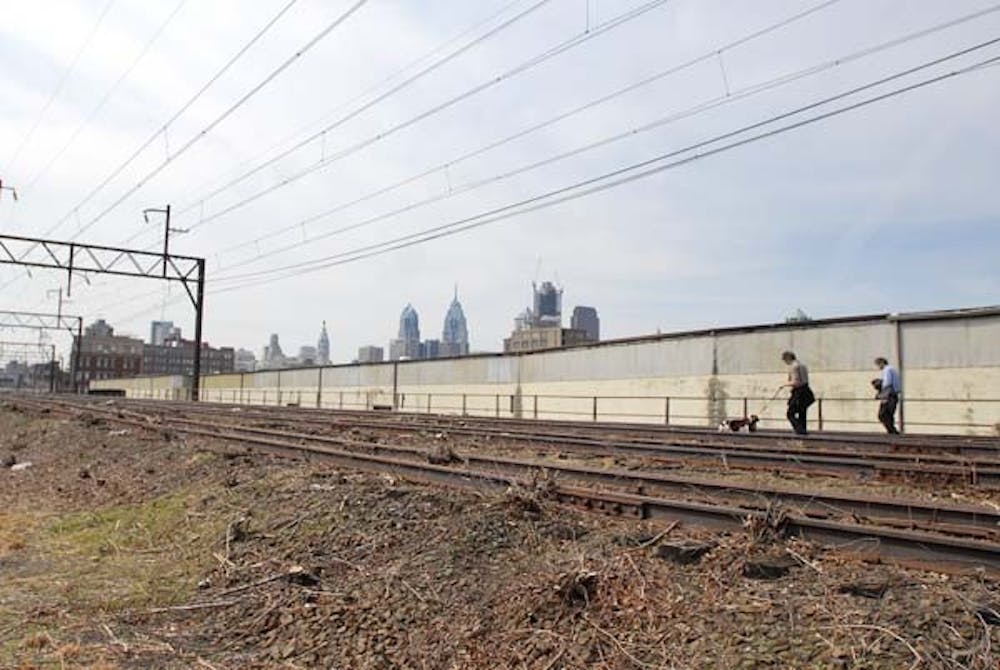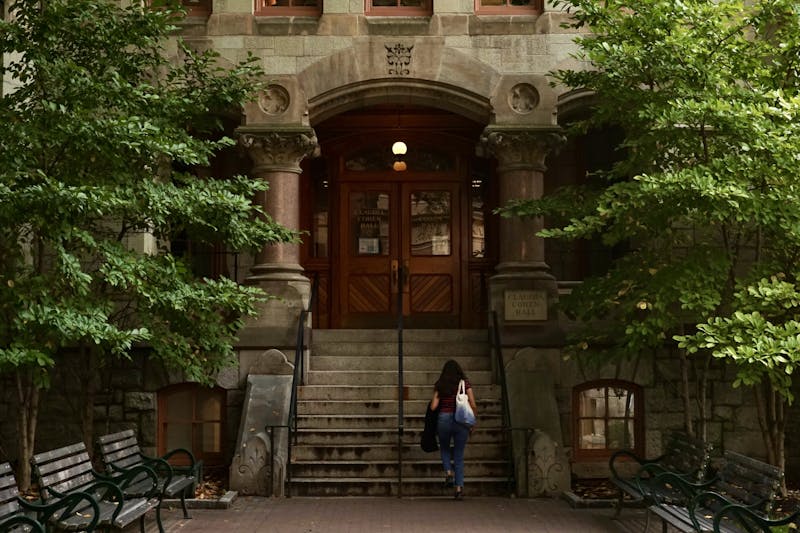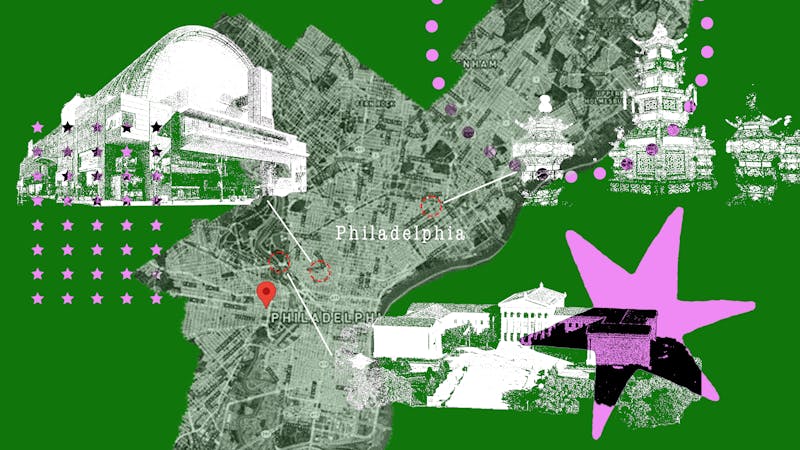
Standing outside on a cold March morning, Joshua David sees the results of eight years of labor.
When it isn't raining, Bobcat loaders pound away at concrete, hauling away gravel ballast and piles of railroad tracks. The gentle whir of sandblasting against dull steel usually penetrates the air. The work has left little but a gray, bathtub-shaped viaduct for David to glimpse from his perch.
For the 1984 College graduate, his dream of turning a 1.45 mile long, elevated railroad track into a park that winds and twists its way, 30 feet in the air, through the west side of Manhattan will finally come to fruition in mid-2008.
One hundred miles away, on the outskirts of Center City, residents also have dreams of finding a similar new use for another abandoned railway in the sky. But, due to a combination of a lack of funds, leadership and sheer will, the project has largely stalled.
But, with New York as an example, things may be looking up in Philadelphia as well.
A shining example
David co-founded the Friends of the High Line in 1999, which sought to reuse the High Line with the support of the city government, neighborhood activists and celebrities.
The line was completed in 1934. Use declined until 1980, when the last train carried three carloads of frozen turkeys to the Gansevoort Market. Two decades later, then-Mayor Rudy Giuliani approved the structure's demolition.
David and his group quickly intervened, filing a lawsuit and holding fundraisers to save the line for reuse. "It was sort of a crazy idea, and we didn't know if anybody would support us," he said. "As soon as we began to open up a public discussion about it, an incredible number of people rallied around us."
Since FHL's intervention, the project has moved ahead rapidly. With $170 million in public and private funding and a daring architectural design, the project has already started to transform the area: Thirty-one private developments are already slated for or under construction near the line.
"The presence of being near the High Line really does make these buildings more marketable," David said, pointing out that a new condominium sold every unit before plans were even released.
Despite the group's role, David noted that the project ultimate success is "really attributable to the Bloomberg administration, and their ability to move it forward," he said.
Rusting rails
In 1893, the Reading Railroad completed construction of its flagship station: Reading Terminal.
Reading's passenger trains finally ended their journeys in the heart of Center City, on the second floor of the Terminal. Elevated rail tracks, now called the Reading Viaduct, ran north out of the station and split into a fork just beyond Vine Street. One spur quickly curved underground to the west. The other, four tracks wide, bent diagonally northeast to Ninth Street, slicing up blocks and parcels along the way.
The stone, dirt and steel structure was built to last - and it has. But most of the local factories, like the old Shoe Factory on Wood Street, shut their doors decades ago. Long-distance travelers were won over by cars and planes decades ago. The viaduct even outlasted the Reading Railroad itself - SEPTA took over passenger service in 1976.
Eight years later, the viaduct joined the crowd of obsolete landmarks in Callowhill when SEPTA rerouted Reading's Center City tracks underground, allowing through passage for all its regional rail lines to Suburban and 30th Street stations.
Its two southernmost blocks were torn down in the early 1990s to accommodate I-676 and the conversion of Reading Terminal into the Convention Center.
The remaining viaduct continued to languish. Trees bloomed 30 feet above city streets, but the viaduct created dark alleys and unusable lots, disturbing the urban fabric and depressing the area.
"It casts pretty dark shadows on the areas that it passes through," said John Chin, executive director of the nearby Philadelphia Chinatown Development Corporation.
Little surprise then that, while Center City's real estate boom has hit other bordering neighborhoods, only modest development has entered Callowhill or Chinatown North. Some, like Chin, advocate tearing down the viaduct to revitalize the neighborhood and build affordable housing.
But other residents, drawing inspiration from New York's West Side, want to find a new use for the viaduct instead.
Fits and starts
From his four-story building that abuts the abandoned viaduct where it forks apart, John Struble only sees potential.
In 2004, the 61-year-old woodworker co-founded the Reading Viaduct Project, which sought reuse the rusting structure. He and fellow resident Sarah McEneaney created a Web site and organized a local petition drive.
At about the same time, Kyle Gradinger was earning his master's degree in city planning at Penn.
After visiting the viaduct, he was so struck by the structure that he convinced Penn's School of Design to sponsor a four-day, school-wide competition to come up with ideas for utilizing it.
"People around the world know what the Reading Railroad is - to tear it down would be a big mistake," he said.
One group proposed building a boardwalk over the viaduct and using former railroad signals to light the area; another suggested turning the viaduct and nearby empty, triangular parcels into a university with a dining car gliding up and down refurbished tracks.
But despite the proposals, the project has only "moved ahead in fits and starts," Struble said. According to most people involved, the lack of progress signals a larger problem: a lack of municipal leadership.
Tale of Two Cities
"Philly isn't the way it is by happenstance," said Erik Johanson, who works for a regional economic-development think tank and lives near the viaduct. "The city, for much of its history - dating back to its Quaker roots - has been averse to progress."
Philadelphia and New York may both be large, post-industrial metropolises separated by a mere 100 miles, but they are worlds apart.
"It's emblematic, when you talk about the tale of two cities, of different administrations and different resources," said Harris Steinberg, who runs Penn Praxis, the School of Design's consulting arm.
Leadership, or the lack of it, Steinberg explained, begins at the mayoral level.
"John Street is a good mayor," he said. But "he is challenged in terms of . getting people behind his ideas."
Without the avid support of a Bloomberg-like figure, many say, the Reading Viaduct project has stalled.
One of the city's few involvements with the viaduct was to commission a study to examine the feasibility of either tearing it down or turning it into a park.
Laura Spinner, Center City planner for the City Planning Commission - the agency that is supposed to be charged with guiding development in the city - said the commission is still waiting for the feasibility study to be completed.
The study, which projected costs of $5.1 million to renovate and landscape the viaduct and $35.5 million to tear it down, was completed in 2004.
Starting to get it
The view from Struble's warehouse hasn't changed much in the five years he's been there. And little change has occurred in the three years since the feasibility study and design competitions were completed.
But that may not be the case for long. Earlier this year, the city hired Penn Praxis to create a master plan for the Delaware River waterfront. The move may spark a wider shift in how the city views development and creating a long-term vision.
"That's what the viaduct program was about, that's what the High Line is about, that's the waterfront is about," Steinberg said. A new mayor could easily seize upon this project make it reality, he added.
In little more than a month, Philadelphia voters will have the chance to send a signal by deciding if the planning commission members hsould be planning professionals and community representatives - currently, there are no qualifications.
Making the Planning Commission an effective force is another step, many say, but it's a start.
"It takes a very long time to reverse 40 years of neglect. They are starting to get it," Johanson said. "Slowly, they are starting to get it."
Be sure to check out the audio slideshows for both the High Line and the Reading Viaduct that accompany this story. Click here to see the feasability study.
And check out Google Maps to view aerial photos of the Reading Viaduct.
The Daily Pennsylvanian is an independent, student-run newspaper. Please consider making a donation to support the coverage that shapes the University. Your generosity ensures a future of strong journalism at Penn.
DonatePlease note All comments are eligible for publication in The Daily Pennsylvanian.







